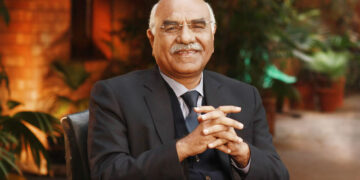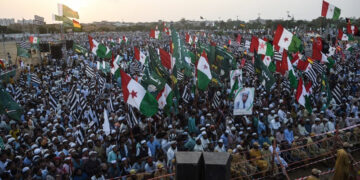[contentblock id=1 img=adsense.png]

Last Thursday we ran through the history behind the rise and fall of one of Pakistan’s largest student organisations, the Islami Jamiat Taleba (IJT).
This week we shall analyse the evolution of another controversial student outfit, the All Pakistan Mohajir Students Organisation (APMSO) – the student party that became the leading reason behind the decline and at times ouster of the IJT from Karachi’s major universities and colleges. APMSO was formed at the University Of Karachi (KU) in 1978 by Altaf Hussain and Azeem Ahmed Tariq.
Husain and Tariq were both students at KU. Whereas Hussain till 1977 was a sympathiser of the Islami Jamiat Taleba (IJT) and played an active role in the movement against the Zulfikar Ali Bhutto regime that was orchestrated by the Jamat-i-Islami-led Pakistan National Alliance (PNA) in 1977, Tariq had flirted with an assortment of progressive student groups, including the Liberal Students Federation (LSF) that was headed by the current PPP Senator, Raza Rabbani at the KU in 1974.
Background
The most common account of the formation of the Muttahida (originally Mohajir) Qaumi Movement (MQM) and APMSO (that gave birth to the MQM) involves claims that it was a party conceived by the military dictatorship of General Ziaul Haq as a way to counterbalance the influence of certain political forces in Sindh. However, there is precious little clarity on the part of those political historians who toe this claim. The Jamat-i-Islami (JI) was the first party to assert that the Zia regime had ‘created MQM’ to sideline JI’s influence in Karachi, even though between 1977 and 1984, the JI was openly supporting Zia.
In the late 1980s, Pakistan People’s Party (PPP) insisted that the MQM had been formed by Pakistan’s intelligence agencies to curb the PPP in Sindh, whereas Sindhi nationalist parties were of the view that MQM came into being at the behest of the Zia regime because of the way Sindhi nationalists had protested during the violent anti-Zia MRD movement in Sindh in 1983. Nevertheless, if one were to summarise the collective thesis on the subject by academics who have written extensively on the MQM – such as Muhammad Wasim, Laurent Gayer and Oskar Vaarkaik – one can suggest that, though, there was some involvement of Zia’s agencies in the formation of the MQM (from APMSO), this experiment soon backfired when the MQM quickly spun out of the agencies’ orbit and became an aggressively independent entity.
[contentblock id=2 img=adsense.png]
The MQM’s arrival was not simply about a Mohajir-centric student organisation (APMSO) evolving into a mainstream political party born out of the political and economic frustrations of Mohajirs. One can treat this as an immediate historical snippet, but it is certainly not the complete story. Academics specialising in the politics of Sindh, such as Amir Ali Chandio and Dr Tanvir Tahir, trace back the formation of the political Mohajir ethnicity way back to the 1960s. Along with Punjabis, Mohajirs dominated Pakistan’s initial ruling and economic elite and thus both these communities continued to invest their political support in either federalist or religious parties or in military dictatorships.
Even those Mohajirs and Punjabis who joined outfits led by Sindhi, Pashtun, Bengali and Baloch nationalists (such as the National Awami Party (NAP), were largely part of the NAP’s Marxist wing that wanted to eschew politics of ethnicity and work towards a bourgeoisie-led socialist proletarian revolution. But by the late 1960s, much of the country’s leftist tendencies were absorbed by the emergent PPP, and thus progressive non-Punjabi and non-Mohajir nationalists became more exclusivist. Consequently, the first ever demand to separate Karachi from Sindh and recognise the Mohajirs as a distinct ethnicity actually came from an influential faction of the left-wing National Students Federation (NSF) that was associated with the NAP. In 1969 Amir H. Kazmi, the head of his own faction of the Marxist NSF, was one of the first political leaders to raise the banner of Mohajir nationalism.

But few Mohajirs took the notion seriously, as they were still firmly imbedded in the concept of federalism and (like Punjabis) repulsed by ethnic nationalism. However, as most of the left-leaning Punjabi and Sindhi intelligentsia and working classes and peasants invested their support in the federalist PPP, Mohajirs stuck to continue backing the federalist Islamic parties. By the late 1960s Mohajirs had already begun to be dislodged from the Punjab-dominated ruling and economic elite with the gradual entry of the dictator Ayub-Khan-initiated entrance of the hardworking Pashtuns in the cherished fold.
The rise of the PPP-led by Z A. Bhutto further added to the sense of dread rising amongst Mohajirs. This erupted in the shape of 1972 ‘language riots’ in Karachi when the Bhutto regime reintroduced Sindhi in educational institutions and Mohajirs saw this as ‘an attack on Urdu.’ The aftermath of the riots saw the formation of a city government movement (CGM). Studded with Mohajir intellectuals and former Karachi-based leftist student leaders and some businessmen, it again called for Karachi to be separated from Sindh.
[contentblock id=3 img=adsense.png]
This movement too failed to take off until the 1978 formation of Altaf Hussain’s APMSO. The much overlooked reason behind the APMSO’s evolution into giving birth to MQM (in 1984) is an economic one. According to famous Sindhi scholar, Ibrahim Joyo, ‘Punjabi economic hegemony’ increased immensely in Sindh during the dictatorship of Ziaul Haq.
This situation had a negative impact on Karachi’s leading business communities (Memons, Gujaratis and other non-Punjabi business outfits). In such a situation these communities formed the Maha Sindh (MS) — an organisation set up to protect the interests of Karachi’s Memon, Gujarati and Mohajir businessmen and traders. According to celebrated Sindhi intellectual Khaliq Junejo, the MS then encouraged and financed the formation of a ‘street-strong’ Karachi-based party. This party became the MQM.
It can be argued that it is this aspect of the MQM’s formation that sometimes gets mistaken into meaning that the party came about with the help of the Zia regime. This is so because the business communities in Karachi (stung by Bhutto’s nationalisation policies) were anti-Bhutto and had hailed his overthrow by Zia in 1977. But by the early 1980s, they had been deluded by Zia’s supposedly ‘pro-Punjabi’ economic manoeuvres in Sindh and felt the need to have their own political outfit. MQM was the result. Beginnings APMSO was formed in 1978 by Azeem Ahmed Tariq (a former member of the Liberal Students Federation) and Altaf Hussain (a former simpithaiser of the JI and IJT). Both Altaf and Tariq came from lower middle-class Mohajir (Urdu speaking) families in Karachi. Hussain was disappointed with the role the Jamat-i-Islami (JI) played after the PNA movement cornered Bhutto and paved the way for the General Ziaul Haq military coup in July 1977.
Hussain in his autobiography, ‘My Life’ claims that he criticised JI for joining the Zia regime and then accused the party of exploiting the Mohajirs of Sindh (especially Karachi) who had been supporting JI ever since the 1950s. A number of ethnic-nationalist student groups had emerged in educational institutions in the 1970s, especially in Karachi, and Hussain thought that the Mohajir youth were being alienated in an environment where Sindhi, Baloch and Pushtun students were asserting themselves through their respective organisations.
Fearing that the Mohajirs will be wiped out if they did not organise themselves as a separate ethnic group, Hussain launched the All Pakistan Mohajir Students Organization (APMSO).


APMSO’s early membership involved a sprinkling of former IJT members and politically neutral students (all Mohajir). In 1981, APMSO decided to join the United Students Movement (USM) – an anti-IJT/anti-Zia alliance of left-wing and progressive ethnic-nationalist student groups at the KU such as the Baloch Students Organisation (BSO), Punjabi Students Association (PSA), Pakhtun Students Federation (PkSF) and Jeeay Sindh Students Federation (JSSF). During the same period another left-wing anti-Zia/IJT student alliance had also sprung up at KU. It was called the Taleba Ittihad (Student Alliance) and was formed by the National Students Federation (NSF) and the Peoples Students Federation (PSF), the student-wing of the Pakistan Peoples Party.
APMSO did not perform well at the 1980 student union elections at KU, but managed to double the number of its votes as a loose component party of USM during the 1981 union elections. By now APMSO had also started receiving Mohajir student activists from the left-wing (and rapidly disintegrating) NSF. The arrival of former NSF members helped shift Altaf and Azeem’s rhetoric further to the left. In a 1981 speech, Hussain described APMSO as a progressive and secular student party working against ‘Punjab’s hegemony in Pakistan’s politics and economics’ and against the ‘mullah-feudal nexus.’
Hussain had already been arrested (in 1979) by the police for allegedly burning the Pakistani flag to protest against the supposed ill-treatment matted out to the Mohajirs by the Punjabi ruling elite.

Perturbed by the rapid growth in the membership of the APMSO, the fundamentalist IJT went on the offensive against it, especially at the KU. It barred the entry of APMSO leaders from KU in 1982 and also attacked APMSO members. IJT had been enjoying the majority of the Mohajir students’ votes in student union elections in Karachi across the 1970s, but now saw the growth of APMSO as a threat to IJT’s chances of retaining Karachi’s major student unions. What’s more, the APMSO had already joined an anti-IJT alliance, the USM.
APMSO members were ‘expelled’ from the KU by IJT at a time when IJT was involved in a tense electoral and armed tussle with progressive student groups across Karachi’s colleges and universities.

APMSO moved its operations to the Mohajir majority areas in Karachi (mohallahs), and in 1984 the senior members of the outfit launched the Mohajir Qaumi Movement (MQM) – an ethnic Mohajir party that was to serve as the senior partner of the APMSO.

APMSO was radicalised when in 1985-86 the first (of the many) major clashes took place between Karachi’s Mohajir and Pushtun communities. The Pushtuns were supported by the Pushtun speaking Afghan refugees who had poured into Pakistan during the US-Saudi funded Islamic Muhajideen insurgency against Soviet and Afghan militaries in the Soviet-occupied Afghanistan. Many of these refugees arrived in Karachi with sophisticated weapons and drugs. The sudden growth in the population of Karachi began putting great pressure on the city’s infrastructural resources and also triggered a two-fold growth in the crime rate.
The simmering tension between the Mohajir community and the Pushtuns erupted in widespread violence when a Mohajir college student, Bushra Zaidi, was crushed by a speeding mini-bus that was being driven by a Pushtun. College and school students poured out onto the streets to protest. The protests soon culminated into clashes between the students and the police and ultimately between the Mohajirs and the Pushtuns.

Faced by the superior firepower brought in by Afghan refugees, MQM dispatched a delegation of APMSO members to Hyderabad to meet a militant group from the Sindhi separatist student organisation, the JSSF. Though Sindhi nationalists had been campaigning against Mohajirs ever since 1950s (accusing them of treating the Sindhis like ‘Red Indians’), Altaf began warming up to JSSF’s mentor and figurehead, Sindhi scholar, GM Syed. APMSO were given some firearms by PSF in the early 1980s, it was JSSF that sold the APMSO its first large cache of AK-47s that were then used to tame the heavily armed IJT in 1987 and 1988, eventually breaking IJT’s hold at KU and in various other state-owned campuses in Karachi.
After the violent end of the Ziaul Haq dictatorship in 1988, MQM swept the 1988 elections in Karachi and got into a ruling alliance with the Pakistan Peoples Party (PPP) at the centre and in Sindh. But soon, both the parties’ student units were headed for a clash. The tussle began as a turf war in universities and colleges of Karachi where IJT’s hold had weakened and where both APMSO and the PPP’s student wing, the Peoples Students Federation (PSF), moved in to claim the space left behind a retreating IJT. Student unions that had been banned by Zia in 1984, were revived by the first Benazir regime. But student union elections were only held in the Punjab, even though elections did take place in some colleges of Karachi and were mostly swept by APMSO candidates followed by PSF.
But lacking the chance to settle political differences through the ballot, clashes broke out between APMSO and PSF in the city’s major universities. The clashes between the two student groups became so intense that the APMSO formed special militant units, Nadeem Commandos and Black Tigers. The Black Tigers were initially created to check dissenters within the MQM. PSF retaliated with its Karachi President, Najeeb Ahmed (a KU student), organising militant units inside the PSF.

Dozens of students from both sides lost their lives and in 1990, the clashes ultimately began straining the PPP-MQM alliance. MQM resigned from the government (of Prime Minister Benazir Bhutto) and joined the opposition. The clashes came to a sudden halt when an armed group youth allegedly belonging to the Black Tigers assassinated PSF’s Karachi chief, Najeeb Ahmed (in late 1989), and by early 1990s, Benazir Bhutto’s first government fell (dismissed by the President).
Turmoil
APMSO and MQM ruled supreme in Karachi during the early part of the first Nawaz Sharif government (1991-93), but certain acts of violence against some army personnel stationed in Karachi by APMSO boys led the military to begin a ‘clean-up operation’ in Sindh (1992). Though the military and Prime Minister Sharif claimed that the operation was aimed against the dacoits (highway robbers) of Sindh, the operation’s main thrust was always directed towards MQM/APMSO’s militancy and alleged ‘criminality.’

By the time Benazir was reelected in 1993, the military had handed over the proceedings of the ongoing operation to the police and paramilitary forces in Karachi (the Rangers). The operation was aggressively led by Benazir’s interior minister, Naseerullah Babar. Gruesome acts of violence were committed by both the sides and the regime also used extra-judicial ways to eliminate the militant backbone of the MQM. Dozens of policemen were slaughtered by MQM/APMSO militants, but hundreds of MQM/APMSO activists were also put to death in the most brutal manner. In 1992-93, when an anti-Altaf faction of MQM (MQM-Haqiqi) emerged (backed by the military intelligence), Altaf Husain escaped to London and Azeem Ahmed Tariq was assassinated.
By 1996, leaders of the Nadeem Commandos and Black Tigers were also eliminated. The operation only came to an end when through a military coup General Parvez Musharraf toppled Nawaz Sharif’s second government in October 1999.
The leveling
In 1998 MQM and APMSO changed the word Mohajir in their names to ‘muttahida’ (united) to suggest that they were no more a Mohajir ethnic party. It now began explaining itself as a secular, centralist national party. In 2002, MQM became any ally of the Musharraf dictatorship and a new crop of leaders, both in MQM and APMSO, began the process of rebuilding the two organisations. Altaf still presided over both the outfits as chief (from London). APMSO also began regenerating its militant wing. This wing came into play during the 2007 anti-Musharraf Lawyers Movement (which, MQM being a Musharraf ally was against).
MQM and APMSO were accused by anti-Musharraf parties and the media for instigating violence on the streets of Karachi when Chief Justice of Pakistan (CJP) Iftikhar Chaudhry (who had been dismissed by Musharraf) arrived to hold a lawyers’ rally in Karachi. In May 2007, fierce gun battles erupted on the streets of Karachi between APMSO militants and armed men belonging to the youth wings of Awami National Party, Jamat-i-Islami and Pakistan Peoples Party. The violence began when MQM/APMSO gunmen allegedly fired upon anti-Musharraf/pro-CJP rallies that were moving towards the airport to receive the ousted CJP. Dozens of people were killed in the ensuing gun battles and riots.

After the 2008 elections MQM joined the PPP-led coalition government along with the Pushtun nationalist party the ANP. But this time around truce between the three parties’ student-wings has held on campuses of Karachi. However the more militant members of the wings that got involved in street crimes and were initially used as muscle by the three parties, many of them went ‘rouge’ and have gotten involved in vicious battles of turf in the city targeting each another to control the lucrative land scams and bhatta (extortion) business.
All three parties, the PPP, MQM and ANP are now struggling to reign in these ‘rouge elements.’ Nevertheless, the APMSO today continues to be the dominant political student organisation in Karachi’s state-owned colleges and universities. And though armed, it does not contain any special militant units like the ones it bred in the 1980s and 1990s (Black Tigers and Nadeem Commandos). A number of former APMSO leaders have now gone on to become leading members of the MQM.
Bibliography: Hussain, Altaf: My Life’s Journey (Oxford, 2011); Talbot, Ian: Pakistan: A Modern History (Palgrave Press, 1998); Verkaaik, Oskar: Migrants & Militants (Princeton University Press, 2004); Gayer, Laurent: Guns, Slums & Yellow Devils (Cambridge, 2007); Waseem, Muhammad: Ethnic Conflict in Pakistan: A Case of MQM (Pakistan Development Review, 1996). -Dawn












